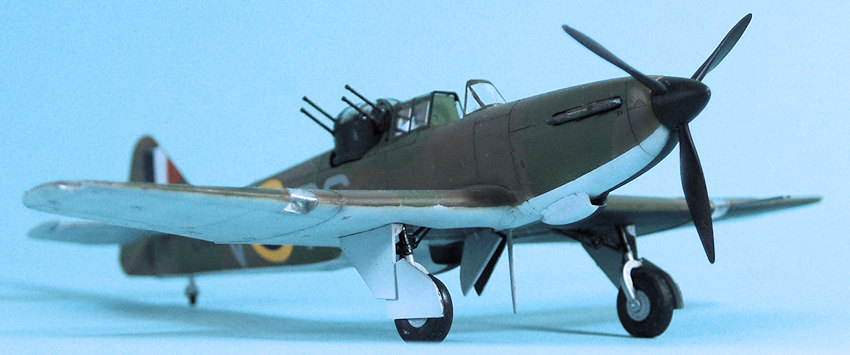
Airfix 1/48 Defiant Mk.I
| KIT #: | A05128 |
| PRICE: | $29.99 SRP |
| DECALS: | Two options |
| REVIEWER: | Tom Cleaver |
| NOTES: | SNew tool kit (2016) |

| HISTORY |
One of the worst developments in air combat, the concept of a turret armed defensive fighter emerged in 1935, when the RAF planned to defend Britain against massed formations of unescorted enemy bombers in air combat that more resembled fleet actions. In theory, turret armed fighters would approach an enemy bomber formation from below or from the side and coordinate their fire, as though two battle lines opposed each other. Separating the tasks of flying the aircraft and firing the guns would thus allow the pilot to concentrate on getting the fighter into the best position while the gunner engaged the enemy.
 Specification F.9/35,
issued that year, requested a two seat day and night "turret fighter" capable of
290 mph at 15,000 ft. Boulton Paul had experience with turrets from their
Overstrand bomber and submitted the P.82 design. Of the seven proposals
tendered, the P.82 was ranked second after Hawker’s Hotspur but ahead of
Armstrong Whitworth’s twin engine design. Prototypes of the P.82 and the Hotspur
were built. Production orders were prepared for the Hotsput, but the Boulton
Paul turret gained the Air Ministry's attention. With Hawker focused on the
Hurricane, the P.82 received a production order in
1937 and the Hotspur order was canceled in 1938.
Specification F.9/35,
issued that year, requested a two seat day and night "turret fighter" capable of
290 mph at 15,000 ft. Boulton Paul had experience with turrets from their
Overstrand bomber and submitted the P.82 design. Of the seven proposals
tendered, the P.82 was ranked second after Hawker’s Hotspur but ahead of
Armstrong Whitworth’s twin engine design. Prototypes of the P.82 and the Hotspur
were built. Production orders were prepared for the Hotsput, but the Boulton
Paul turret gained the Air Ministry's attention. With Hawker focused on the
Hurricane, the P.82 received a production order in
1937 and the Hotspur order was canceled in 1938.
The central feature was the four gun turret, based on a design by the French aviation company SAMM, which Boulton Paul had licensed for use in the earlier Sidestrand bomber but eventually installed in the "follow up" design, the Overstrand, and the Blackburn Roc naval fighter. The turret was an electro hydraulically powered "drop in" unit with a crank operated mechanical backup, equipped with four 0.303 in Browning machine guns. The first prototype, K8310, was rolled out in 1937 without its turret. It resembled the Hurricane, though it was 1,500 lb heavier and powered by the same 1,030 hp Merlin I. The newly-named Defiant prototype first flew on 11 August 1937, a year ahead of the Hotspur. A second prototype, K8620 was equipped with a turret. With the turret installed, the Defiant had a top speed of 302 mph. 713 Defiant Mk. I aircraft were built.
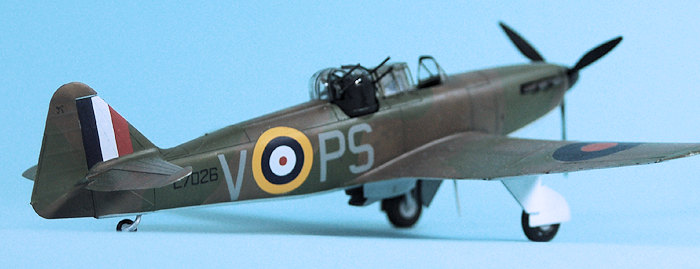 No. 264 (Madras
Presidency) Squadron was reformed at RAF Sutton Bridge in October 1939 to
operate the Defiant. Training and development of tactics began when they
received the first Defiants in early December at Martlesham Heath, with night
fighter training commencing in February 1940. 264's CO, Squadron Leader Philip
Algernon Hunter, flew against Robert Stanford Tuck in a Spitfire, and
demonstrated that the Defiant could defend itself by circling and keeping its
speed up. By March 1940, 264 had two flights operational, and 141 Squadron
received its first Defiant. When the Defiant was publicly introduced, the RAF
put out a disinformation campaign that the Defiant had 21 guns: four in the
turret, fourteen in the wings and three cannon in the nose.
No. 264 (Madras
Presidency) Squadron was reformed at RAF Sutton Bridge in October 1939 to
operate the Defiant. Training and development of tactics began when they
received the first Defiants in early December at Martlesham Heath, with night
fighter training commencing in February 1940. 264's CO, Squadron Leader Philip
Algernon Hunter, flew against Robert Stanford Tuck in a Spitfire, and
demonstrated that the Defiant could defend itself by circling and keeping its
speed up. By March 1940, 264 had two flights operational, and 141 Squadron
received its first Defiant. When the Defiant was publicly introduced, the RAF
put out a disinformation campaign that the Defiant had 21 guns: four in the
turret, fourteen in the wings and three cannon in the nose.
264 flew their first mission on 12 May 1940, with the Defiants escorted by six Spitfires of 66 Squadron; a Ju 88 was shot down over the Netherlands. The next day the Defiants claimed four Ju 87s, but were then attacked by Bf 109Es. The escorting Spitfires were unable to prevent five of the six Defiants being shot down in frontal attacks.
During the evacuation of the B.E.F. from Dunkirk, 264 was based at RAF Manston, to cover the evacuation. On 27 May, the Defiants claimed three He-111s destroyed and two damaged. The next day, shortly after takeoff, ten Defiants were attacked by 30 Bf 109s. Forming a circle, they claimed six 109s for the loss of three Defiants.
264 was initially
successful because the enemy often mistook the Defiants for Hurricanes and
bounced them from the rear. The best day was 29 May 1940, when 264 claimed 37
kills in two sorties: 19 Ju-87 Stukas, most picked off as they came out of their
dives; nine Bf-110s; eight Bf-109s, and a Ju 88. One Defiant gunner was lost
when he bailed out, though the pilot brought the aircraft back to Manston. The
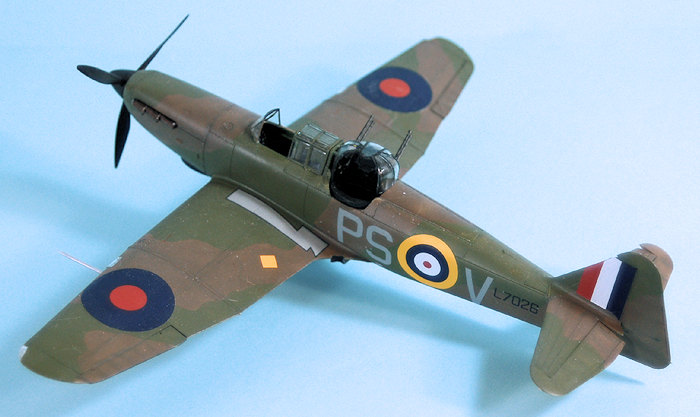 most successful Defiant crew was Flight Sergeants E.R. Thorn, pilot, and F.J.
Barker, air gunner, who claimed 13 victories by the middle of August 1940.
most successful Defiant crew was Flight Sergeants E.R. Thorn, pilot, and F.J.
Barker, air gunner, who claimed 13 victories by the middle of August 1940.
The Luftwaffe soon changed tactics against the Defiant, with 109 pilots attacking from below or dead ahead, wheere the turret had no coverage. Defiant losses quickly mounted, particularly among the gunners, who often were unable to get out of their turret. The additional weight of the turret and second crewman combined with the aerodynamic drag meant the Defiant had a lower performance than conventional single seat fighter.
264 developed a defensive maneuver in which the Defiants were flown in an ever descending Lufbery circle. This sacrificed the advantage of height but eliminated attack from below, while giving 360 degrees of defensive fire. While 264 found success with this tactic, when the Defiants of 141 Squadron were committed during the Battle of Britain they chose to ignore the advice of 264 - with devastating consequences. On 19 July, seven of nine 141 Squadron Defiants sent to cover a convoy off Folkestone were shot down by Bf-109s of JG 51; the remaining two only survived, one badly damaged, by the intervention of Hurricanes from 111 Squadron. The Hurricanes reported the Defiants had shot down four Bf 109s.
Although 264 Squadron had claimed 48 kills in eight days over Dunkirk, the loss of 14 Defiants (out of 16 in the squadron) was a high price to pay. Actual German losses were 12-15 aircraft, making the victory-loss ratio 1:1; the overclaiming was due to the turret’s wide angle of fire allowing several Defiants to engage the same target simultaneously, leading to multiple claims.
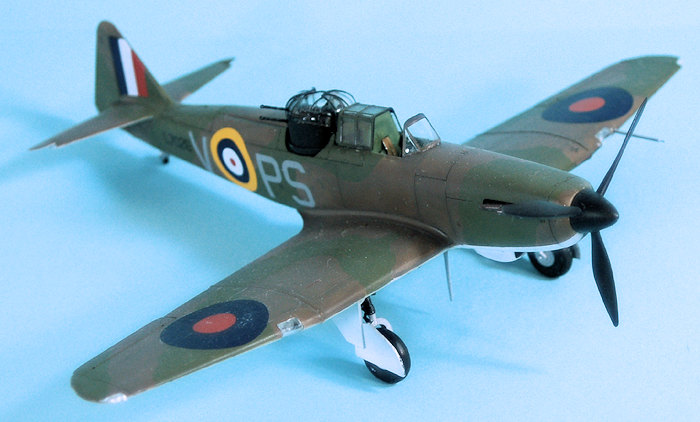 On 24 August, three
Defiants were lost, including Squadron Leader Hunter. On 26 August, as the
Defiants engaged 12 Do-17 bombers over north eastern Kent, they were attacked by
Bf-109Es of JG 3. Three were lost, including two credited to Hauptmann Gunther
Lutzow. Six Do-17s and one Bf-109 were shot down in return. Three of these
victories were awarded to the top-scoring team of Flight Sergeants Thorn and
Barker, who shot down two Do-17s but were then engaged by a Bf-109 which set the
Defiant on fire; they managed to shoot down their attacker before making a
forced landing. Two days later the squadron lost five Defiants to JG 26, with
nine crew members killed. With these losses, the Defiant – which had been
intended from the start as a day and night fighter – was transferred to night
operations, and there it achieved some success.
On 24 August, three
Defiants were lost, including Squadron Leader Hunter. On 26 August, as the
Defiants engaged 12 Do-17 bombers over north eastern Kent, they were attacked by
Bf-109Es of JG 3. Three were lost, including two credited to Hauptmann Gunther
Lutzow. Six Do-17s and one Bf-109 were shot down in return. Three of these
victories were awarded to the top-scoring team of Flight Sergeants Thorn and
Barker, who shot down two Do-17s but were then engaged by a Bf-109 which set the
Defiant on fire; they managed to shoot down their attacker before making a
forced landing. Two days later the squadron lost five Defiants to JG 26, with
nine crew members killed. With these losses, the Defiant – which had been
intended from the start as a day and night fighter – was transferred to night
operations, and there it achieved some success.
Had the Defiants been sent to Scotland as replacements for Hurricanes and Spitfires, they might have been more successful in opposing the unescorted German attacks from Norway and Denmark, which would have employed them in the role and in the battle conditions they had been designed for.
| THE KIT |
In 1/48 scale, the
Defiant was one of the first kits from Classic Airframes. The less said about
that first kit the better; several years later Classic Airframes attempted to
correct the many errors in the first release with a second release that is no
less difficult to assemble, but does make up into a fairly-accurate model.
Fortunately, Airfix released this 1/48 Defiant in February 2016, to go along
with their recently released and really quite nice Hurricane I and Spitfire I.
Unfortunately for modelers outside the UK, the entire first run of t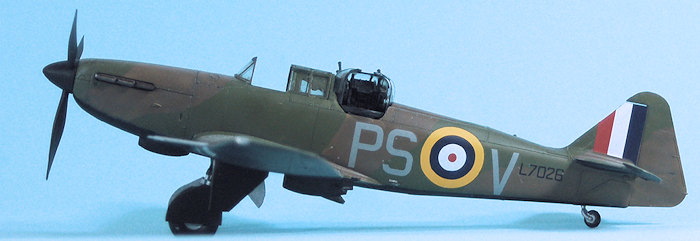 he kit was
sold out domestically and the only North American modelers who laid hands on the
kits were those who had ordered one from overseas suppliers. Fortunately, there has been
a second run produced and delivered, and the kit was available at the end of
May, though this run appears to have sold out now; the word is a third run of
the kit will be available this fall.
he kit was
sold out domestically and the only North American modelers who laid hands on the
kits were those who had ordered one from overseas suppliers. Fortunately, there has been
a second run produced and delivered, and the kit was available at the end of
May, though this run appears to have sold out now; the word is a third run of
the kit will be available this fall.
This Airfix kit is based on research done with the sole surviving Defiant, which is displayed at the RAF Museum. The outline shape is accurate, the interior is good for the scale, and the turret is excellent. There are alternatuive parts to allow a modeler to build the model with the pilot’s canopy open or closed, and the turret can also be assembled open or Decals are provided for two day fighters in the Battle of Britain - a 264 Squadron Defiant and a Defiant from II (Army Cooperation) Squadron. The decals include full stenciling and an instrument panel for the pilot’s cockpit.
| CONSTRUCTION |
Once again: if you follow the very clear instructions in the very nice instruction booklet Airfix supplies, you will have guaranteed an excellent result.
I painted the cockpit interior details, then assembled the fuselage. I found it a good idea not to install the rear turret fairing until after the turret is installed at the end of the assembly process after the model has been painted and decaled, in order to allow room for the turret to be popped into position.
I then assembled the wing, mated that to the fuselage, and attached the oil cooler, radiator and horizontal stabilizers. This all took only a few hours to complete. I decided to assemble the model with the turret open.
| COLORS & MARKINGS |
 I decided to do the
markings for the 264 Defiant as flown during the Dunkirk campaign. At that time,
the Defiant was classed a day and night fighter, and had a camouflage of Dark
Green/Dark Earth upper surfaces with black/white lower surfaces.
I decided to do the
markings for the 264 Defiant as flown during the Dunkirk campaign. At that time,
the Defiant was classed a day and night fighter, and had a camouflage of Dark
Green/Dark Earth upper surfaces with black/white lower surfaces.
Airfix shows the camouflage pattern accurately, so I first painted the model black and white on the lower surfaces, then Dark Earth and Dark Green on the upper surfaces in the “A” scheme, using Xtracrylix. The nice thing about Xtracrylix is you get a smooth coat airbrushed or brushed, and the same shade. Thus, I could outline the Dark Green areas for the pattern with a 001 brush for the “hard” edge, then fill it in with my airbrush. I used the kit decals for this model.
The model was then given a coat of Xtracrylix flat varnish, the landing gear and prop were attached, the turret was installed and the canopy was glued in position with white glue.
| CONCLUSIONS |
This Defiant looks good sitting next to the Hurricane I and Spitfire I models Airfix released that are in my collection. I am likely to do another once I lay hands on a kit, to use the very nice Xtradecals sheet to do a night fighter. The kit is excellent value for money, easy to assemble, and the result is an attractive model of an interesting airplane.
21 July 2016
Copyright ModelingMadness.com
Thanks to my billfold for the review kit.
If you would like your product reviewed fairly and fairly quickly, please contact the editor or see other details in the Note to Contributors.